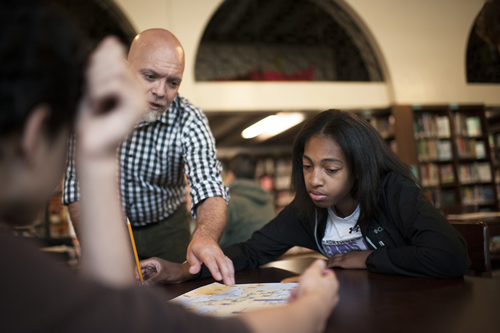The following article is a re-post of 5 best practices for teaching challenging subjects by Melissa Mott.
One of the most effective ways to cultivate skills such as empathy, problem solving, and emotion management is to help students productively struggle through an examination of the real and complex subjects that have and continue to face the world. Conversations on topics like racism, genocide, school shootings, and other forms of violence are not easy; however, honest dialogue can lead to increased understanding and compassion for the human experience.
As a former high school teacher now working with Echoes & Reflections, an organization that helps middle and high school educators build their confidence and capacity to teach the Holocaust effectively, I’ve discovered some best practices for teaching challenging subjects.
1. Prepare academically and emotionally
Teaching complex subject matter without the right tools and guidance can be detrimental to students’ understanding. Teachers can avoid this with equal parts emotional and academic preparation.
To start, become a student again. Commit to learning through reliable and trusted resources. Attend in-person and/or online trainings with subject-matter experts, and read many texts from different credible perspectives. It can be tough to balance your own emotional reaction to teaching atrocity, so challenge yourself to the extent that you can.
Once you’ve mastered the content, explore alternative materials like movies, poetry, and survivor testimonies. These are the stories that ground your teaching practice in truth. The humanities discipline engages the core question of what it means to be human, so seek to find your own humanity before teaching students.
2. Develop support systems
Creating or seeking a professional learning community is paramount to effectively teaching the Holocaust and other difficult topics. Either through your school, district, or professional development opportunities, having a group of people with whom to bounce ideas, brainstorm, and gain knowledge is critical in forming effective pedagogical techniques and teaching rationale.
In our Echoes & Reflections training sessions, we include time for teachers to consider how to answer inevitable questions from students. While it’s impossible to anticipate everything, we explore what might come up and allow educators to exchange and consider answers in a safe environment.
3. Create a safe space
Invest time to create a culture of openness and support within the classroom. I once heard a teacher say: “To effectively teach genocide, one must stoke the flames of students’ curiosity and then control the blaze.”
Just as teachers need to prepare to teach difficult topics, students need the same opportunity to think critically and digest them. Challenging students’ understanding of humanity will likely lead them to experience a full arc of emotions, and we need to be ready to support them. Continued interrogation into morality, ethics, and collective action are what make these subjects most impactful for students.
Try engaging students in critical memory questions. Don’t be afraid to facilitate difficult conversations about how a tragic event in history affects current events. For instance, what does it mean that young people take “selfies” in concentration camps? Asking students to do the heavy lifting on how the world engages with a complex topic helps them understand the repercussions felt each day.
Teachers should also allow students to form and explore their own connections between what they are learning and elements of their own lives. While every event is unique, the emotions and feelings that we share as humans can help us connect on meaningful levels with the experience of others, regardless of time, geography, or culture.
4. Follow culturally responsive pedagogy
Following culturally responsive pedagogy hinges on knowing your students and their unique viewpoints. This practice helps teachers frame materials in a way that is most relevant for their students.
Ask your students questions and really listen to their answers. Contact their parents/caregivers. Explore community resources and invite different voices into the classroom. When you take an interest in students’ lives and experiences, they will guide you to what is important to them. Research has revealed that creating meaningful connections with students helps create more successful and engaged learners.
Mario Perez, a veteran teacher who works with English language learner high school students, aligns his teaching style with what he knows about his students, who come from culturally and geographically diverse areas of the world. “Recognizing that some of my students are living in shadows and that some feel persecuted or have suffered from persecution in their countries of origin changes how I cover topics in the classroom,” he says.
5. Bring students “safely in and safely out”
Providing leadership and guiding students “safely in and safely out” of difficult subject matter creates a space that is supportive and sacred. Without minimizing the topic, teachers should step into a topic gradually.
Part of providing a safe study of complex topics means focusing not just on despair and loss but also hope and humanity. Highlight the stories of those whose actions, small and large, bring light to the darkness. We want our students to feel a sense of agency as they come out of this study.
